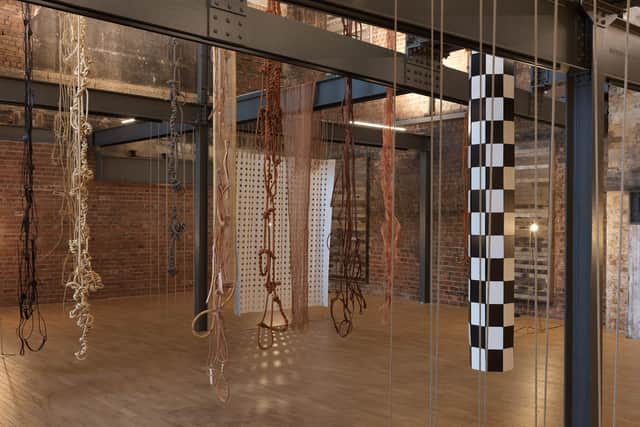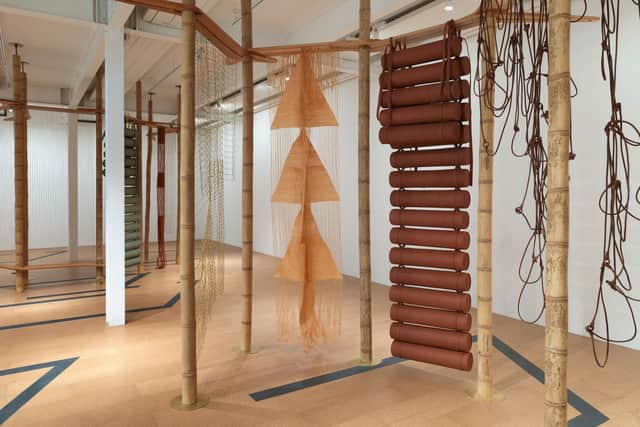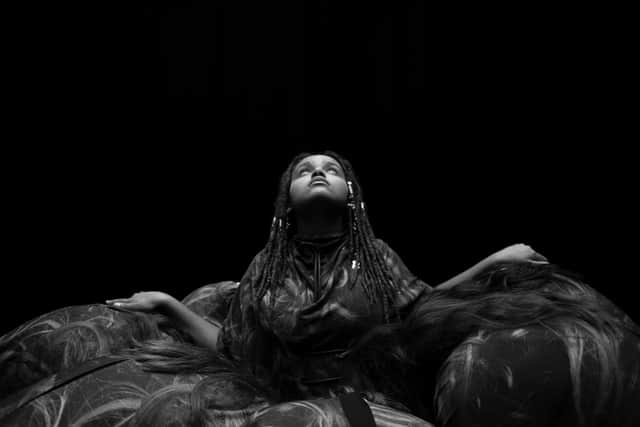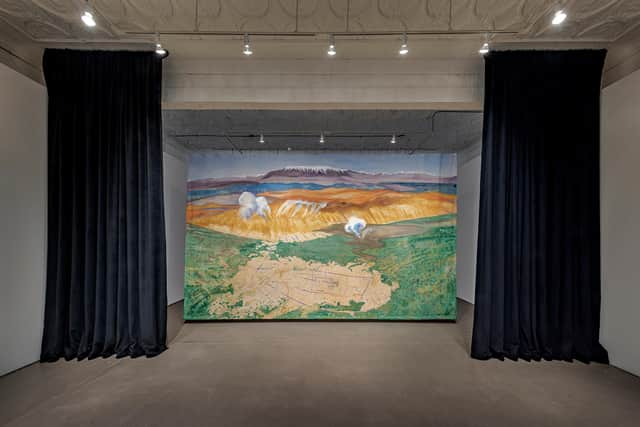Edinburgh Art Festival reviews: Leonor Antunes | Jessie Jones | Lawrence Abu Hamdan
Leonor Antunes: The apparent length of a floor area, Fruitmarket Gallery, Edinburgh ***
Jessie Jones: The Tower, Talbot Rice Gallery, Edinburgh ***
Lawrence Abu Hamdan: 45th Parallel, Talbot Rice Gallery, Edinburgh ****


Advertisement
Hide AdEdinburgh’s galleries all make a special effort at festival time. This year many are opting to present international artists, like the Fruitmarket Gallery with the first Scottish exhibition by Portugese, Berlin-based Leonor Antunes, who will be new to many.
Hers is a practice which foregrounds making. Antunes’ sculptures are made of leather, fabric, woven rope – often predominantly soft materials, and often suspended from frames, from the roof or from wall brackets. Whether they are made by the artist herself or made for her, they are meticulously crafted and their suspended nature gives them a light, ethereal quality.
Antunes responds to each space in the way she installs, creating three different moods in the Fruitmarket’s three main spaces. Her pieces often reference the work of women designers and architects from the 20th century: there are a host of them here, from Charlotte Perriand (French), Lena Bergner and Trude Guermonprez (Bauhaus designers who fled Germany in the 1940s) to Sadie Speight (British) who worked with her husband Leslie Martin on the Royal Festival Hall. The cork floor in the galleries is taken from a plan by Marian Pepler whose rugs were made by Edinburgh Weavers in the 1930s.
In the main downstairs gallery, three large bamboo frames act as supports for a range of sculptures inspired by different designers. The frames themselves are inspired by a chaise longue designed by Perriand, and the title, “the homemaker and her domain” comes from a Perriand essay.


Upstairs, there is more light and space. Woven works hang from wall brackets; a delicate net of metal links hangs from the ceiling. On the floor are three low, table-like forms (again referencing Perriand), made of ceramic but with the imprinted texture of a Mexican rush mat.
In the warehouse space, there are coils of leather, copper wire, rattan. Some are suggestive of bundles of bridles or other riding tack; in fact, the whole space has a stable-like quality with its dim light, distressed brickwork and delicate divisions made using thin ropes which loop from floor to ceiling, giving the impression of stalls.
Advertisement
Hide AdThe works are quietly impressive in their attentiveness to detail, their precise, tactile quality, and the careful way they define their relationship to the space. But what is their relationship to those designers of the past? How is Antunes referencing or using their work? If she was on a mission to revive them, she would tell us more about them. Her titles sometimes add their names – Sophie, Ruth, Charlotte, Lena – which creates a sense of a private conversation between friends to which we, the viewers, are not invited.
Perhaps we don’t need to know in order to appreciate the work for its material and spatial qualities, but the lack of information conveys a deliberate reticence. For all its craftsmanship and accomplishment, it leaves one with the sense of a conversation happening behind closed doors.


Advertisement
Hide AdIrish artist Jesse Jones, whose new installation The Tower is at Talbot Rice, also references women of the past. The Tower is the second work in a trilogy which began with Tremble, Tremble, shown at the Venice Biennale in 2017 and commissioned and curated by Talbot Rice director Tessa Giblin. There are clear aesthetic similarities: Jones is again working with performer Olwen Fouéré, with high-definition film, sculpture and an immersive set of elements which are manipulated by a live performer.
Again, her subject is society’s attitudes to women (Tremble, Tremble was made as Ireland prepared to vote on repealing the country’s abortion laws). Also, like the earlier work, it takes a broad sweep through history, from medieval female mystics to the suppression of women in asylums and Magdalene laundries in Ireland in the last two centuries. Women such of Julian of Norwich and Hildegard of Bingen are referenced, and most particularly Marguerite Porete, burned as a heretic in 14th-century Paris, with the texts of her mystical writings strapped to her body.
The work revives the energy of that mysticism with its atmospheric lighting and sound, breathy voices, and the performances (on film) of Fouéré, Naomi Moonweld-Nhosi and a group of other young women choreographed in movement and song, and with the presence of the live female performer. There is a statue, sacred totems, a peep-hole through which one can glimpse an anchorite’s cell. Spending half an hour in the darkened space, one becomes slightly enchanted.
But perhaps, conceptually, it’s trying to do too much. It feels like a stretch to link the mystics (a handful of exceptional individuals) to the widespread wrongful incarceration of women who defied moral and religious sensibilities in more recent times. It’s true that patriachal society is too quick to seize on labels like “saint” or “heretic”, and that shame has long been part of the arsenal of weapons used against women, but is this work about repression or empowerment? While the spell it casts is powerful, one is left with only a hazy sense of what it is trying to communicate.


There is a welcome sense of clarity about Talbot Rice’s other festival exhibition, Lawrence Abu Hamdan’s 45th Parallel. It’s something of a depature for Hamdan, one of the winners of the 2019 Turner Prize (when the shortlisted artists shared the prize at their own request), whose previous work has often paid forensic attention to sound.
This film (which is displayed along with three painted scenic backdrops) begins like a documentary, with Danish-Palestinian film director Mahdi Fleifel voicing Hamdan’s script from the Haskell Free Library and Opera House, a building which sits on the border of Canada and the USA, and serves communities in both countries. As long as those attending return to the country they came from, it remains a neutral zone in which the border (marked by a black line on the floor) can be freely disregarded.
Advertisement
Hide AdAs such, it has been the centre of various stories: a drug smuggler used it as a drop-off point until he was rumbled by the librarians because of his fine clothes. Poignantly, students from Middle Eastern countries in the Trump era used it to meet their families who could not get visas to visit the US; the helpful librarians waived the “no talking” rule for them.
But Hamdan also has a much more serious purpose, another border story about a Mexican teenager (on the Mexican side of the border) shot in 2010 by a US border patrol agent on the US side. Mexico’s attempts to extradite him went to the US Supreme Court, to be quashed 5-4 by Trump appointees. Had it been allowed, the case could have opened the floodgates for legal challenges on some of the 44,308 civilians killed on foreign soil by US drones. It’s not without import that this small but vitally important point of law is explored in the space directly above Edinburgh University’s Law Library.
Advertisement
Hide AdBorders matter, even when they are absurd, and this theme is expanded on the Georgian Gallery balcony with a series of concrete poems by Hephzibah Israel, a senior lecturer in translation studies at Edinburgh University. Israel writes from the perspective of someone who grew up “on the margins of multiple communities”. Her work reflects the absurdity of borders in an increasingly multicultural world, and the fact that the spaces between them are often – like the Haskell Free Library – the most culturally and creatively fertile.
Leonor Antunes until 10 October; Lawrence Abu Hamdan and Jessie Jones: The Tower end 30 September